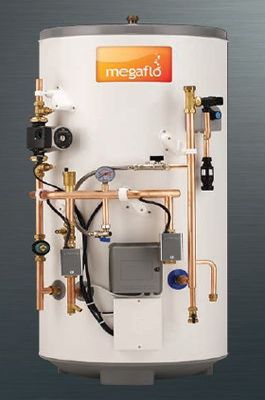WHAT IS AN UNVENTED HOT WATER STORAGE CYLINDER?
An unvented hot water storage cylinder is a way of keeping hot water at mains water
pressure to improve the water flow around a home.
In the UK, hot water has traditionally be kept in open vent storage cylinders. 'Open
vent' simply means that there is an permanently open overflow pipe which allows water
to discharge into the cold water storage tank if it becomes too hot.
Water kept at mains pressure can't be kept in open vent cylinders as the water would
simply keep flowing out of the open vent at mains pressure.
Instead, hot water in an unvented mains pressure system is kept in a storage
cylinder without a permanently open vent, hence the term 'unvented'.
HOW DOES AN UNVENTED HOT WATER CYLINDER WORK?
An unvented hot water cylinder works by storing hot water at mains pressure in a reinforced
cylinder so that when a hot water tap is opened the hot water is delivered at mains
pressure.
This means that an unvented hot water storage cylinder can usually supply more than
one outlet at once and can supply outlets on floors above the one where the cylinder
is positioned by using mains water pressure to push the hot water up to the higher
floors.
To cope with the mains water pressure unvented cylinders have to be built much stronger
than standard open vent cylinders.
Also, because hot water is locked in at mains pressure there are safety devices fitted
to prevent the cylinder exploding should the pressure get too high, either because
the mains pressure itself is too high or because the water gets too hot, expands and
turns to steam.
UNVENTED HOT WATER CYLINDER SAFETY DEVICES
An unvented hot water storage cylinder has a series of safety devices to protect the
user and the household, principally:
-
A line strainer to filter the water entering the
cylinder so debris and grit in the water supply doesn't damage any of the safety controls
-
A pressure reducing valve to bring the
mains pressure down to a maximum of 3bar.
-
A check valve or non-return valve to stop water
stored in the cylinder from flowing back down the supply pipe and into the mains drinking
water supply.
-
An expansion vessel, basically a container
to hold water when it expands under heat.
-
A thermostat to control the temperature
of the water in the cylinder.
-
A temperature/pressure relief valve, typically
a combination valve that will allow water to escape to a special discharge pipe if
the water gets too hot or the pressure in the unvented hot water cylinder gets too
high.
ADVANTAGES OF AN UNVENTED CYLINDER
Hot water in traditional open vented cylinders is stored at low pressure with gravity
providing the force to distribute the water around the home.
This works well in a home where the hot water cylinder and the cold water storage
tank that feed it are high up in the home (typically the cold tank in the loft and
the hot water cylinder on the first floor) and where the distribution pipework is
of a wider bore (3/4" or 22mm or more) to ease the water flow.
However, gravity based systems may struggle to provide enough hot water simultaneously
to more than one outlet, such as a shower outlet when a tap is being opened elsewhere
on the home, or where there are outlets above the height of the storage cylinder,
such as on a second floor or in a loft conversion.
An unvented cylinder can overcome this problem by storing the hot water at mains pressure
(typically limited at around 3bar) so that the pressure is much greater and better
able to cope with more than one outlet open at once.
Multiple unvented hot water cylinders can also be linked together on the hot water
system to increase the storage capacity provided that the mains water pressure and
flow rate is sufficently high.
DISADVANTAGES OF AN UNVENTED CYLINDER
Because unvented hot water storage cylinders are built to very high strengths and
have a number of sophisticated safety controls they are both more expensive to buy
and more expensive to fit than traditional open vented cylinders.
They should only be installed by qualified persons holding a current unvented cylinder
installation certificate. Each installation must be registered with the Building Control
Department of the local government authority for the property.
Building Control will usually want to inspect the installation unless it has been
self-certified by a qualified installer who is a member of a 'competent persons' scheme
such as 'WIAPS'. Building Control Departments usually
charge a fee for the inspection
Because of the number of safety devices on an unvented hot water storage cylinder
it is important that they are serviced every year by a competent person.
When purchasing a property where an unvented hot water storage cylinder is installed
you should insist on seeing the service history of the cylinder as an unserviced cylinder
can develope faults that are expensive to repair.
TYPICAL
UNVENTED HOT WATER STORAGE CYLINDER
AND CONTROL SYSTEMS
 |
|